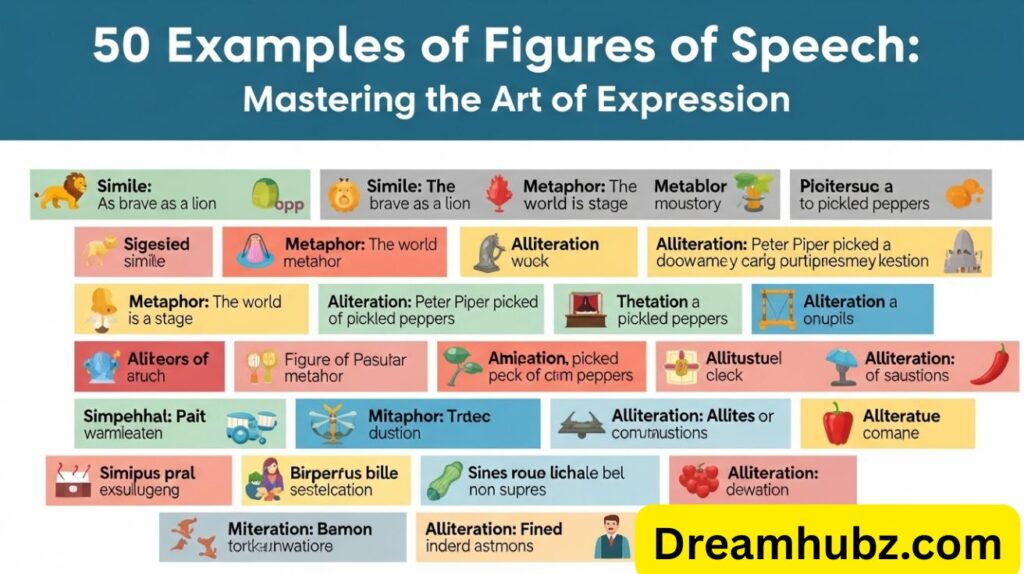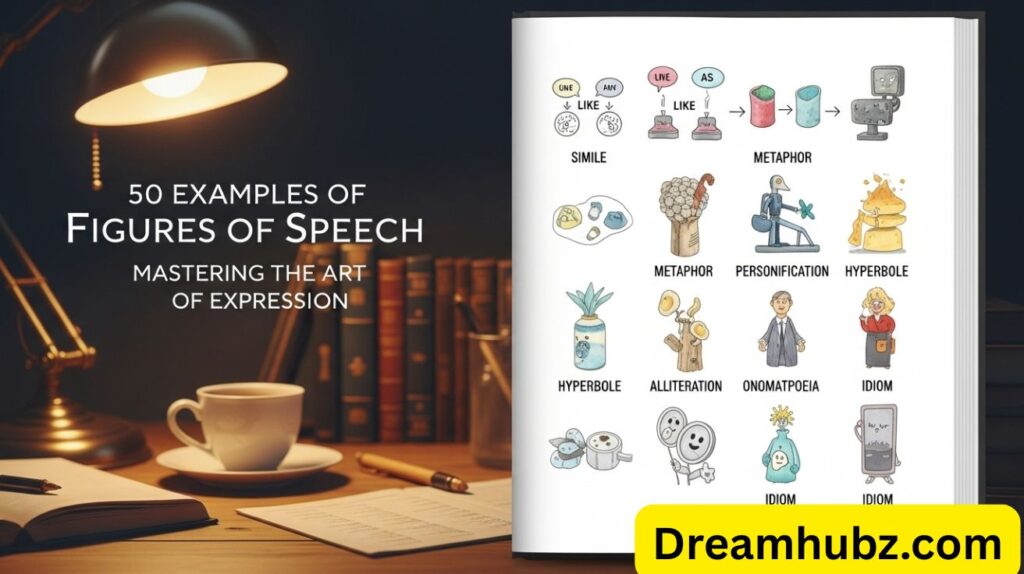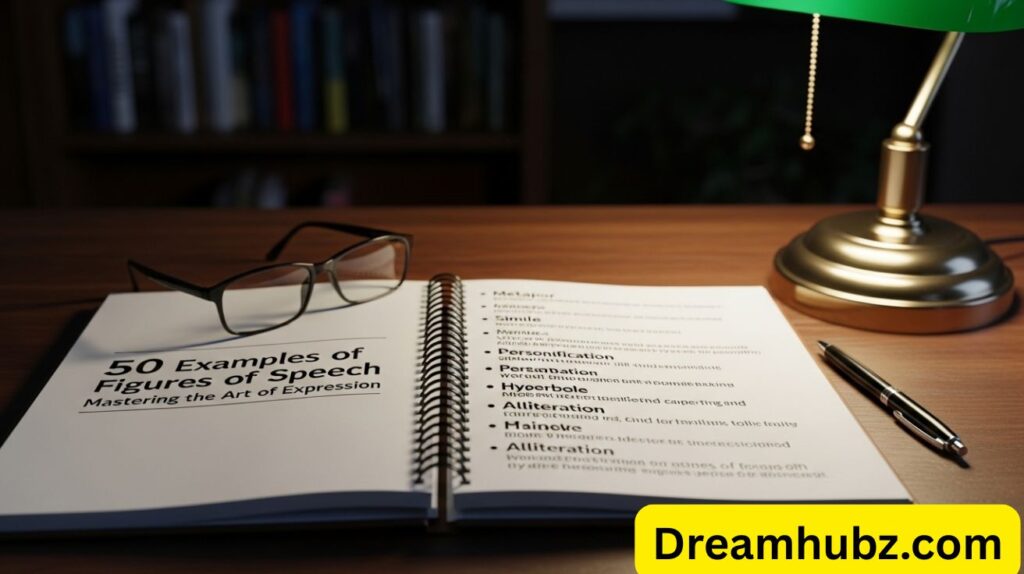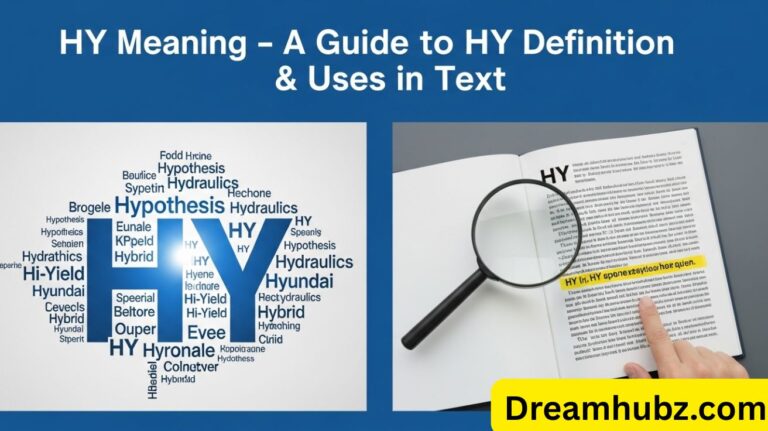50 Examples of Figures of Speech: Mastering the Art of Expression
Examples of Figures of Speech are special ways of using words to create meaning beyond the literal. They make language more colorful and expressive. Writers and speakers use them to explain ideas in creative ways.
They make words come alive. They add beauty, humor, and power to language. Without them, communication would feel plain and dull.
Examples of Figures of Speech include simile, metaphor, personification, and hyperbole. They are common in stories, poems, and daily speech. Each type helps us express thoughts more clearly and with impact.
The Power of Figurative Language

Figurative language is what transforms plain text into something memorable. Instead of sticking to literal meanings, writers use tropes and schemes to create imagery, stir emotions, or highlight contrasts. For instance, when someone says, “Time is money,” they are not speaking literally but are using a metaphor to stress the importance of time. This is the magic of linguistic devices—they allow us to say more with less, to intensify emotions, and to create mental images that stick.
In expressions in English, figurative language plays a central role. It helps explain abstract concepts by grounding them in real-world comparisons. In fact, most persuasive writing techniques rely on figures of speech to engage the audience. From presidential speeches filled with anaphora to common English idioms like “break a leg,” these devices are deeply embedded in American culture. Understanding them is not only a matter of grammar and style, but also of mastering creative writing tips that can make your communication powerful and memorable.
Metaphors: Painting Pictures with Words
The metaphor is perhaps the most well-known and widely used figure of speech. A metaphor makes a direct comparison between two unlike things without using “like” or “as.” By saying, “The world is a stage,” Shakespeare condensed the complexity of life into a single, striking image.
Examples of metaphors include statements like “Life is a roller coaster,” “Her voice is music to my ears,” and “He is a couch potato.” These comparisons are not meant to be taken literally, but they add depth and emotional power to language. In business communication, metaphors are used to simplify complex ideas, while in literature they enrich characters and themes. Even in advertising, metaphors help brands connect emotionally with consumers.
Writers and speakers who master metaphors unlock one of the strongest literary techniques in the toolbox of expressive language. As the photographer Ansel Adams once said, “Metaphor is the lifeblood of all art.”
Similes: The Art of Comparison
Unlike metaphors, a simile makes a comparison using the words “like” or “as.” This is another fundamental rhetorical figure in speech that is easy to understand but highly effective. When we say “as busy as a bee,” we immediately capture the energy and industriousness of the subject in question.
Examples of similes include “He is as cool as a cucumber,” “Her smile is as bright as the sun,” and “She is like a bull in a china shop.” These are not literal descriptions but poetic devices examples that help audiences visualize and feel the intended message.
In American classrooms, similes are among the first stylistic devices in literature that students encounter. They are a favorite in poetry, song lyrics, and even casual conversations. Learning to use similes effectively is one of the most useful writing improvement tips for anyone who wants to add clarity and impact to their communication.
Personification: Bringing Objects to Life
Personification is a technique where human qualities are given to non-human objects, ideas, or animals. This makes the inanimate seem alive, engaging, and relatable.
Examples of personification include “The wind whispered through the trees,” “The sun smiled down on us,” and “Justice is blind.” In these cases, abstract ideas and natural forces are described with human traits, which makes the language more colorful and emotionally engaging.
In American advertising, personification is common because it helps consumers connect emotionally with products. Think of slogans where cameras “love” people, or cars that are described as “faithful companions.” In literature, personification creates vivid imagery that makes stories more memorable, especially in children’s books where animals and objects take on human roles.
Hyperbole: Exaggeration for Effect
Hyperbole is deliberate exaggeration used for emphasis or humor. This exaggeration in literature and speech is not meant to be taken literally but serves to highlight feelings or ideas.
Examples of hyperbole include “I’ve told you a million times,” “He’s older than dirt,” and “I’m so hungry I could eat a horse.” Americans, known for their direct and dramatic storytelling styles, often rely on hyperbole in everyday expressions.
Hyperbole is especially powerful in comedy and advertising. A stand-up comedian may exaggerate experiences to make audiences laugh, while a brand may exaggerate product benefits to capture attention. However, overuse of hyperbole can undermine credibility, so it should be balanced carefully.
Understatement: The Power of Saying Less
An understatement does the opposite of hyperbole by downplaying a situation. When someone says, “It’s just a scratch” while bleeding heavily, the understatement creates irony and humor.
Examples of understatement include “I’m a bit tired” after running a marathon or “It wasn’t my best day” after losing everything. In American culture, understatement is less common than in British humor, but it still plays a role in casual conversations and literary works.
This device is often used in tense situations to reduce conflict or to create subtle humor. In persuasive writing techniques, understatement can help a speaker come across as modest and relatable.
Oxymoron: Contradictions that Make Sense
An oxymoron is a linguistic device where two contradictory words are placed together, creating a phrase that is both puzzling and profound.
Examples of oxymoron include “bittersweet,” “deafening silence,” and “living dead.” Such phrases capture the complexity of life by combining opposites. In literature, they are used to create tension, while in casual speech they add humor or drama.
In U.S. politics and journalism, oxymorons often appear to highlight paradoxical situations, such as “virtual reality” or “open secret.” Their power lies in their ability to reveal truth through contradiction.
Alliteration: The Music of Repeated Sounds
Alliteration is the repetition of consonant sounds at the beginning of words. This device adds rhythm and musicality to language, making it easier to remember.
Examples of alliteration include “Peter Piper picked a peck of pickled peppers” and “She sells seashells by the seashore.” In branding, U.S. companies like Coca-Cola, Best Buy, and Dunkin’ Donuts use alliteration to make their names catchy.
Alliteration is one of the most effective literary techniques for slogans, poetry, and tongue twisters. It not only captures attention but also reinforces memory, making it a popular choice in marketing campaigns.
Onomatopoeia: Words that Sound Like Their Meaning

Onomatopoeia refers to words that imitate natural sounds. Words like “buzz,” “sizzle,” and “boom” are examples that directly connect language to sensory experiences.
In American comic books, onomatopoeia is famously used with sound effects like “BANG!” “POW!” and “ZAP!” It is also common in children’s literature, poetry, and advertising. By mimicking real sounds, onomatopoeia brings writing to life and makes it more immersive.
Idioms: Phrases with Hidden Meanings
An idiom is a phrase whose meaning cannot be understood from the literal words. Common English idioms are deeply embedded in U.S. culture, though they often confuse language learners.
Examples of idioms include “break a leg” (meaning good luck), “it’s raining cats and dogs” (raining heavily), and “bite the bullet” (face a difficult situation). Idioms reflect cultural values and often provide colorful alternatives to literal language.
In journalism, politics, and everyday conversations, idioms help speakers connect with audiences in familiar ways. They are among the most widely used examples of figures of speech in American English.
Euphemism: Softening the Blow
A euphemism is a polite or indirect way of saying something unpleasant. Americans often use euphemisms in workplaces, medical contexts, and politics to soften harsh truths.
Examples of euphemism include “passed away” instead of “died,” “downsizing” instead of “layoffs,” and “let go” instead of “fired.” Euphemisms make conversations less uncomfortable and help maintain social harmony.
In U.S. culture, euphemisms are common in business communication and obituaries, where softer language is considered more respectful.
Synecdoche and Metonymy: Parts Representing Wholes
Synecdoche and metonymy are two closely related figures of speech.
| Device | Definition | Example |
| Synecdoche | A part represents the whole | “Wheels” for car, “the crown” for monarchy |
| Metonymy | A related concept stands in for something | “Hollywood” for film industry, “The White House” for U.S. presidency |
These linguistic devices are often found in journalism, politics, and literature. They allow for shorthand communication that condenses complex concepts into single words or phrases.
Irony: When Words Mean the Opposite
Irony occurs when the intended meaning is opposite of the literal words. This rhetorical figure in speech is divided into three types: verbal irony, situational irony, and dramatic irony.
Examples of irony include a fire station burning down, an English teacher making a grammar mistake, or saying “great weather we’re having” during a thunderstorm. In American sitcoms and political commentary, irony is a key tool for humor and critique.
Irony engages the audience intellectually by making them think beyond surface meanings. It is also one of the most powerful literary techniques for social commentary.
Read Also : Dirty Team Names: Funny, Naughty, and Clever Ideas
Other Notable Figures of Speech
Beyond the main types, many other examples of figures of speech add richness to expressive language. These include:
- Anaphora, the repetition of words at the beginning of clauses, seen in Martin Luther King Jr.’s “I have a dream” speech.
- Chiasmus, an inverted structure such as Kennedy’s “Ask not what your country can do for you…”
- Paradox, a phrase that seems contradictory but reveals truth, like “less is more.”
- Litotes, understatement through negation, such as “not bad” meaning good.
- Apostrophe (literary), where the speaker addresses someone absent, dead, or abstract, as in “O Death, where is thy sting?”
- Puns, playful use of words with double meanings.
- Allusion, indirect reference to culture or history, such as calling someone a “Romeo.”
- Antithesis, pairing opposite ideas for contrast, as in “speech is silver, silence is golden.”
- Analogy, extended comparisons that explain complex ideas.
- Colloquialism, casual everyday phrases unique to American English.
With these additions, we reach a complete language figures list of around fifty examples in poetry and prose, speeches, and everyday expressions.
The Creative Power of Figures of Speech

Figures of speech are more than just decorative literary devices; they are the essence of how we shape meaning. By bending words beyond their literal definitions, they transform simple sentences into powerful messages. In politics, media, and storytelling, these devices allow speakers and writers to connect with audiences on a deeper emotional and intellectual level.
Across cultures, especially in American literature and everyday talk, figures of speech enrich communication. They provide memorable expressions, from common English idioms like “spill the beans” to profound metaphors in poetry. Mastering these rhetorical devices is not only about enhancing grammar and style, but also about developing the ability to persuade, inspire, and leave lasting impressions through expressive language.
Why Figurative Language Matters in Everyday Expression
Figurative language plays a vital role in how we use expressions in English. When we say someone is “as busy as a bee,” we are using a simile that paints a picture of their activity. Such comparisons bring clarity, energy, and humor to conversations, making our communication more dynamic and engaging in both casual and professional settings.
In American culture, figurative language appears everywhere—from political speeches to advertising slogans. It simplifies complex ideas through literary techniques such as metaphor, personification, and hyperbole. By practicing these creative writing tips, anyone can elevate ordinary conversations into compelling narratives. That’s why rhetorical figures in speech remain central to education, storytelling, and effective communication across different contexts.
FAQ,s
What are 30 figures of speech?
They are thirty different types of figures of speech such as metaphor, simile, personification, hyperbole, idiom, irony, euphemism, alliteration, oxymoron, and others that enrich expressive language.
What are 100 figures of speech?
This refers to an extended list of literary devices, rhetorical figures, tropes, and schemes, including both common and rare poetic devices examples found in literature and speech.
What are figures of speech and examples?
Figures of speech are stylistic devices in literature where words convey meanings beyond the literal. For example, “Time is money” (metaphor) or “as light as a feather” (simile).
How many figures of speech are there in total?
There is no universal number; experts classify anywhere from 30 to more than 250 figures of speech, depending on how broadly linguistic devices are defined.
Conclusion
The study of figures of speech is not just about memorizing poetic devices examples or mastering rhetorical devices. It is about learning how to use language creativity to persuade, entertain, and inspire. From the vivid images of metaphors to the playful sound effects of onomatopoeia, from the subtlety of understatement to the contradictions of oxymorons, these stylistic devices in literature shape the way we think and feel.
For anyone aiming to improve their communication, these tools are indispensable. They are not only useful in essays or speeches but also in everyday expressions, where a well-placed idiom or metaphor can make you sound more engaging.
As you experiment with these rhetorical figures in speech, remember that they are not rigid rules but creative possibilities. They are the colors on your linguistic palette. When used wisely, they make your words memorable, persuasive, and deeply human.







